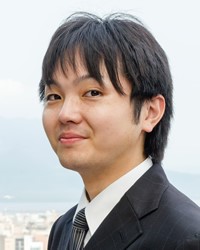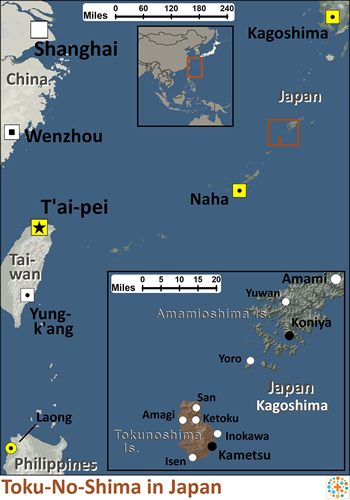The Kunigami of Japan are made up of seven closely related people groups living in the Ryukyu Islands. This small chain of islands, which includes Okinawa, is located to the southwest of Japan, between Kyushu (the southern tip of Japan) and northeastern Taiwan. The Kunigami languages vary from island to island and their dialects from village to village. Although their dialects are all quite similar to Japanese, the tribes are not able to understand one another. Some of the once dominant native languages spoken include Northern and Southern Amami-oshima, Toku-no-shima, Oki-no-erabu, Southern Ryukyuan, and Yayeyama. All of these languages are being replaced by Japanese among the younger Kunigami. What one can say of the Toku-No-Shima can be said of any other Kunigami people.
We don't know for certain when Toku-no-shima Island was first inhabited, but it was first mentioned in a Japanese chronicle in the 720s. In the 1600s, Toku-no-shima was invaded by the samarai, and they entered a time of harsh rule filled with poverty and famine. There was a famine in 1755 where 3,000 people died of starvation and disease. It was under the control of various Japanese rulers until after WWII when it was occupied by US military forces. This lasted until 1953 when it returned to Japanese control.
Toku-No-Shima is an island, but part of a greater island chain. It is noted for having the highest birth rate in Japan and for having a high percentage of people who live beyond 100 years.
The local culture of Toku-No-Shima blends that of their own culture and that of the Japanese. They have their own form of bull fighting. Instead of a man fighting the bull, they have two bulls which they goad into trying to drive the other one outside of a ring. Toku-No-Shima also has its own cuisine, which makes it an interesting place for tourists. Tourists also enjoy seeing the north coast, Mushiroze, with it's chiseled flat stone slabs, beaten by the surf. There are other sites as well, but they discourage hiking because this is the home of the dangerous habu snake.
Tourism plays a smaller part of their economy than light manufacturing and agriculture. They grow sugar cane, sweet potatoes, rice, ginger, and bananas. The climate is far enough south that they can grow some tropical fruits. As expected, commercial fishing is part of their economy as well.
The people of this island are known for having the highest birth rate in Japan, along with a high percentage of people who live beyond 100 years.
Most sources consider the Toku-No-Shima to be Buddhist; however, traditional shamanistic practices are still prevalent. This means that they believe in many unseen gods, demons, and ancestral spirits. They believe the spirits of their ancestors live in the tombs where they were buried. The people believe that these spirits must be regularly invited back into the lives of their descendants, or they will no longer exist. For this reason, each person believes himself/herself to be an extension of the life of the family.
The people also believe that unseen powers known as kami control the ancestral spirits and other areas, including the sea and land. The ancestral spirits are honored on a community level, and the kami are also worshipped privately in the homes. They believe that if the kami are not appeased, they can bring harm to a family or individual. For this reason they seek the guidance of the kami before making an important decision.
The father of the house maintains the religious rituals in the home and cares for the ancestral tombs. The women serve as "mediators" between the kami and the people.
The Toku-No-Shima and other Kunigami peoples need the self-respect that comes from a relationship with the King of kings. They need to know they have much worth in the eyes of their maker.
Pray for the Lord to somehow get through to Toku-No-Shima elders so they can open the door to allow the King of kings to enter their lives.
There are believers among some of the Kunigami peoples. Pray they will take Christ to the others.
Pray for a movement to Christ among every Kunigami people.
Scripture Prayers for the Toku-No-Shima in Japan.
| Profile Source: Joshua Project |

























